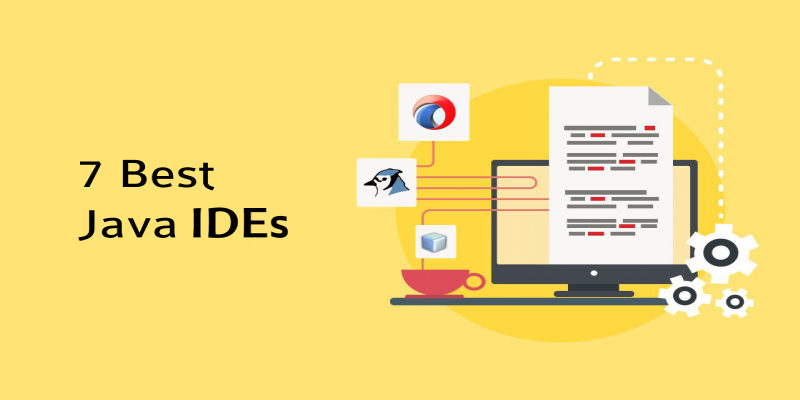
7 Most Popular IDEs for Java Application Development in 2020
Java remains one of the most loved software development frameworks out there. Be it mobile apps or enterprise solutions, developers always look for Java. The popular programming language was designed to use in the internet’s distributed environment. Though Java eventually became more popular as an Android app development platform, programmers of all kinds use the framework alike. Java development companies leverage the comprehensive environment of the framework to create innovative software applications.
Integrated Java Development environments (IDEs) are widely used to build mobile apps, enterprise software, and web applications, among others. In this blog post, we discuss some of the most preferred IDEs for Java development.
Best IDEs for Your Java Development Project
With the right integrated development environment, you get the best out of Java. A good IDE not just enhances your programming efficiency but also creates immense scope for innovation. Here’s a list of IDEs that top Java developers prefer for everything, from Java mobile application development to enterprise software and more.
1. BlueJ
BlueJ was initially developed as a basic IDE for beginners but now has emerged as a top choice of developers. It is a cross-platform IDE that is empowered with a range of robust features. BlueJ has an editor that enables the programmers to scan the code visually, develop dynamic objects, and inspect them as well. They can also invoke the code simply by typing it in without even the need for compilation. Java development companies use this platform for major projects.
BlueJ is usually developed for the teaching of object-oriented programming. The design it has is completely different from other development environments. The main screen shows the class structure. Objects can be created and tested. This combined with a clean, and simple user interface helps in simple experimentation with objects. This is a great feature for beginners to start development work more quickly.
2. Codenvy
Condenvy is a top commercial Java development environment. Condenvy is available in three edition variants. These are the developer, team, and enterprise versions. The custom runtime environment of Condenvy simplifies debugging and testing of Java code. It provides a browser-based editor that can be employed for writing high-quality code with features such as code completion, refactoring, and syntax highlighting.
Codenvy also supports agile methodology which means that it is just the right IDE for building apps faster. It’s a cloud-based and on-demand Java development framework. Codenvy also enables developers to seamlessly debug and simultaneously run multiple projects.
3. Eclipse
Eclipse offers both desktop and cloud editions. While the cloud edition remains the first choice for developers, they can even extend both editions by installing some specific plug-ins for this purpose. The Eclipse Marketplace Client provides a range of plugins and there is also the alternative to create custom ones according to the needs. The IDE offers robust tools for modeling, testing, charting, and reporting. It also facilitates the incremental compilation of the code by rendering a custom compiler.
The main features of Eclipse that attract developers are Windows Builder, Maven integration, Mylyn, XML editor, CVS client, PyDev, and Git client. It also includes workspace having an extensible plug-in system for customizing the IDE to match your business needs. You can install plugins to build applications in other programming languages as well. These comprise of C, C++, JavaScript, Perl, PHP, Prolog, Python, R, and Ruby. Eclipse is available under the Eclipse Public License for Windows, Linux, and Mac OS.
Also Read: How Eclipse IDE for Java EE Developers is Different From Eclipse IDE for Java
4. IntelliJ IDEA
Java developers can use IntelliJ IDEA to gain deeper insights into their codes. The tool offers features such as smart completion, static member completion, chain completion, cross-language refactoring, data flow analysis, etc. IntelliJ helps developers to perform typical coding in an editor-centric environment. The IDE can speed up the development cycle by providing build tools, version control tools, database tools, decompiler, test runner, and built-in terminal.
The Maven build tools, visual GUI builder, ant, and code editor for the XML and Java make it the most preferred IDE. In the community edition, a few features are missing. If you need them you easily get a license to unlock all the features. The IntelliJ Idea community edition is available under the Apache 2 License. It is used extensively for Java mobile application development and similar projects.
5. DrJava
Primarily written for students, DrJava is a simple and lightweight integrated development kit. This framework has gained extensive popularity mainly because of its intuitive user interface. It has features such as go to file, go to the line, and find/replace that simplifies Java programming. It also packs some advanced features such as auto-completion, automatic indentation, syntax coloring, brace matching, and commenting/uncommenting, among others. Besides, DrJava helps developers to evaluate the code interactively.
It is majorly used for software testing, source-level debugger, or to evaluate the text of a program. It also has a program editor that can be used depending on your business requirements. DrJava is available for free under the BSD License.
6. JGrasp
This lightweight Java IDE can run on any platform with JVM 1.5 or higher. Though it is implemented in Java, it produces control structure diagrams (CSDs) for several other programming languages such as C, C++, Objective-C, Python, and Ada. It packs many features to build comprehensive software applications and provides an integrated debugger and workbench for Java.
JGrasp has a built-in feature that allows developers to analyze the data structures. This means they can identify the objects that represent the data structures. For instance, developers can analyze stacks, linked lists, queues, binary trees, and hash tables.
7. NetBeans
NetBeans, the official IDE for Java 8, an open-source Java development framework. It offers a comprehensive set of tools and features for desktop, web, and Java mobile application development, among others. Every new NetBeans version brings improvement in Java editor to enable ease into custom software application development. The tools offered by this IDE empower the Java developers to write bug-free code. They can access the GUI Builder feature to design GUIs without investing extra effort and time.
The NetBeans IDE can be used to build in Java, but also proficient to work with other languages. These comprise of PHP, C/C++, and HTML5. It is cross-platform and supports Microsoft Windows, Linux, Mac OS X, Solaris, and other platforms supporting JVM. It can also be used for working with cloud-based software applications.
Conclusion
Java integrated development environments help developers in so many ways. From simplifying coding to getting deeper insights into programming, JDEs completely enhance the development process. When you decide to hire Java developers for your software project, make sure you ask them to choose the right IDEs. At Java India, a Java development company, we deploy the most advanced IDEs for all development projects. With us, you don’t have to worry about the performance, scalability, or quality of software applications.
FAQs

Q. What are IDEs in Java?
Java IDEs (Integrated Development Environments) are software application which enables users to more easily write and debug Java programs. Many IDEs provide incredibly useful features like syntax highlighting and code completion, which helps the user to code more easily.
Q. How much does it cost to build a Java application?
The costs of developing a progressive Java software application depend on several factors. Design complexity, development time, type of features, etc. play an important role in calculating the costs. Java India delivers feature-rich solutions at a competitive price.
Q. How long does it take to develop a Java enterprise application?
There’s no predefined time for developing a Java app. It varies widely depending on the features of the app and its design. The best way to know an estimated time is to consult development experts. We deliver robust Java software applications in short development time.

